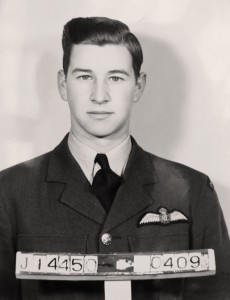Mona Parsons started Day 1,272 in Nazi captivity and watched in horror as the nearby men’s prison exploded into flames. No one inside the ruin survived.
Allied aerial bombs continued to fall that March 24, 1945, targeting the aerodrome and rail links of the German city of Vechta. Nevertheless, collateral damage seemed inevitable, and the women’s detention centre might be next.
Neither Parsons, a 44-year-old Canadian detainee, nor any of her fellow inmates knew that Operation Plunder—the Allied vaulting of the Rhine River—had commenced. Held in cold and damp cells for more than three years, the former Broadway chorus girl and nurse was lucky if she knew what day it was at all.
Amid the chaos, however, came opportunity when the German prison director ordered the gates opened and offered all detainees a choice: either stay and risk a fate similar to their male counterparts or take their chances outside, where Allied aircraft were still whipping up a firestorm.
Parsons looked at her friend, 22-year-old Dutch baroness and resistance member Wendelien van Boetzelaer. This was the moment they had both been waiting for.
Grabbing each other’s hands, they ran.
The stranger-than-fiction tale of Mona Parsons began on Feb. 17, 1901, when she was born in Middleton, N.S., to Norval and Mary Parsons. Later living in nearby Wolfville, her first brush with conflict came at 13, when she volunteered with a Camp Fire Girls group to make clothes for Belgian babies during the Great War, where her father and her brothers, Gwynne and Ross, were serving.
Meanwhile, the young Maritimer nurtured a passion for performing arts, ultimately pursuing a career in music, dancing and acting in the U.S. Alas, her aspirations of becoming a theatre star were never fully realized. Spurred on by the death of her mother in 1930—and perhaps the Great Depression’s impact on the Broadway scene—she retrained and worked as a nurse.
In February 1937, Parsons’ life took a dramatic turn after she was introduced to Dutch millionaire businessman Willem Leonhardt. The two hit it off almost immediately and, following a months-long courtship, they were married on Sept. 1, 1937, in the Netherlands, where the couple decided to live.
Parsons, who took her husband’s name, spent the next two years as a wealthy socialite. When not entertaining guests at her large, lavish house named Ingleside in Laren (near Amsterdam), she enjoyed leisurely mornings with breakfast in bed, gardening, shopping and spending time with her two dogs.
It wouldn’t last. On her second wedding anniversary, the Nazis invaded Poland. Britain responded by declaring war on Germany two days later, stoking fears in neighbouring European countries.
“[T]he worst has happened,” wrote Parsons in a letter to her father at the time, expressing unwillingness to leave: “My place is here.”
Despite having acquired Dutch citizenship, the fact that Parsons was Canadian-born—and, therefore, a British subject—came with grave risks if Hitler decided to invade the Netherlands. Willem purchased her passage back to Canada, but she refused to leave her husband behind and returned the ticket.
On May 10, 1940, European fears were realized when an overwhelming German blitzkrieg swept through the Netherlands, France, Belgium and Luxembourg. The Dutch army fought to expel the would-be occupiers, but the brutal bombing of Rotterdam on the 14th, which killed hundreds, forced the country’s hand.
A surrender was finalized the next day, plunging Holland into a five-year darkness under Nazi-installed governor Arthur Seyss-Inquart. During those bleak and bitter years, the Dutch endured countless hardships, from the theft of wealth and cultural property to the enslavement of hundreds of thousands of their men.
Some 104,000 Dutch Jews were also destined to be murdered by the Nazi regime, and a further 20,000 would die in the 1944-45 famine known as the Hongerwinter (Hunger Winter). More still would be killed for attempting to resist the occupation.
Yet resist they would—including the Leonhardts.
The German prison director ordered the gates opened and offered the detainees a choice: stay or they could take their chances outside.
Joining a small but growing underground network of like-minded individuals, the couple offered their home as a hideout for downed Allied airmen who “stayed for maybe a few hours or perhaps a night before going off somewhere else,” wrote Parsons. Their efforts, just one link in a much larger chain that smuggled crews out of the country, were fraught with considerable risk.
Never was that truer than on Sept. 19, 1941, when Mona and Willem received a dinner invitation to their friends’ house in Amsterdam. Less a social call and more a plea for assistance, the Leonhardts departed the meal with two British flyers.
Their car was stopped at several German checkpoints on the way home. Leaning on the couple’s upper-class credentials, they passed through each without incident as the airmen relied on their false identity papers.
Royal Air Force navigator Richard Pape and flight engineer William (Jock) Moir hid away for six days at Ingleside, occupying the vacant servants’ quarters on the top floor. It was an unusually long stay, but it would be the least of their concerns.
Unbeknownst to the Dutch resistance, their chain had been infiltrated. Pape and Moir were captured before reaching England. Worse, pressure increased on the group itself as the Germans closed in on it.
On Sept. 29, Parsons returned from the dentist to find the Gestapo had called in at Ingleside. Informed by a contact that they were due back any minute, the former Broadway actress prepared to get into character. Her shmoozing endeavours, however, were in vain. She was escorted out of her home and into incarceration.
Deprived of food and sleep, bullied and threatened by her captors who employed numerous interrogation techniques, the undeterred Nova Scotian refused to buckle. Unfortunately, however, the evidence against her became even more damning.
A sole source of comfort was the knowledge that Willem had so far evaded capture, confirmed by exchanged notes snuck out to her contacts. In these scribbled messages, Parsons had enquired about the welfare of her non-existent cat Wimpy. She learned he had escaped twice, but was safe.
Spending almost three months confined to a cell on a bed of straw, Parsons awoke on Dec. 22, 1941, to news that her trial was about to commence. There, struggling to comprehend the German-language proceedings, she was sentenced to death.
As quoted in Andria Hill-Lehr’s biography of Parsons, the defendant recalled of the moment: “I knew that all eyes were on me, expecting me to burst into tears. I was determined not to humble myself before any of them. As I left the courtroom, I put my heels together and bowed toward the judge, the prosecutor and my German counsel…‘Guten morgen, meine herren’ (Good morning, gentleman), I said.”
Parsons’ gracious yet quietly defiant composure impressed the tribunal head, who advised her to appeal the sentence. She did and her punishment was commuted to life in prison.
They approached a man only to notice he wore a Nazi armband. It was too late to turn back. When he offered his home, the women felt they had to accept.
It was better than a firing squad or the rope, although Parsons held no illusions of what lay in store for her. Still, when later thrust into a brief and bittersweet reunion with Willem after his capture, she whispered in Dutch to him under the suspicious glare of the prisoner guards: “Moed en vertrouwen.”
Courage and confidence.
Transferred to multiple German detention centres during the subsequent years, Parsons and fellow female inmates were enslaved by the Nazis, forced to perform labour duties when not confined to their cramped, unhygienic living quarters.
At one facility, she was tasked with peeling sticky paper off reusable cardboard cartons, while she scraped the crumbs out of empty food boxes, attempting to placate her hunger. Elsewhere, an assignment of peeling potatoes afforded her the chance to sneak out leftovers, which she then shared with the other detainees. When no food scraps were available, Parsons described imaginary recipes in mouthwatering detail to boost morale within the dingy, dreary, disease-ridden prison cells.
Never one to submit passively, the Nova Scotian also found ways to resist her captors, utilizing sabotage in the work she was forced to carry out. In knitting socks for German soldiers, she carefully crafted each pair to cause discomfort among troops on the march. As part of the production line for manufacturing enemy bomb ignitors, she shoddily spliced the wires.
On Feb. 6, 1945, Parsons was transferred to Vechta prison. Her latest—and last—detention would be a comparatively short one, eased by her friend Baroness van Boetzelaer who had escaped twice before. The next time, she explained to Parsons, rather than travel west toward the Netherlands, she would go north first.
They would get their chance together.
Through smoke, flames and debris, beset by the ever-ominous drone of Allied bombers, the two women bolted toward the unknown on March 24, 1945.
They needed shelter—and fast.
Whether driven by foresight or adrenaline, Parsons and van Boetzelaer determined that the nearby German aerodrome, notwithstanding the aerial bombardment laying waste to its infrastructure, could offer sanctuary in one of many concrete pillboxes.
Their gamble initially paid off. Running between bunkers, they encountered a German soldier taking cover in a dugout. Somehow, van Boetzelaer convinced the young trooper they were on a work detail outside the Vechta prison confines and would immediately return once the air raid ended. They ran again.
It was merely the beginning of their arduous journey to Holland.
Most pressing was Parsons’ limited ability to blend in with the crowd.
Having started to learn German in captivity, she still spoke with a distinctly Canadian accent that could reveal the ruse. The fugitives concluded that Mona should pose as a woman with mental health challenges, a risk itself because of Nazi policies on what they perceived to be “undesirables.”
With few, if any, other options available, it was deemed the best solution. Feigning an aunt-niece relationship to account for their age difference, the duo set out in the rough direction of the partially Allied-liberated Netherlands.
Inclement weather, inadequate footwear, and an incessant dread of getting caught were just some of the hurdles confronted on their long march through the German heartland. Parsons and van Boetzelaer sought food and lodgings from the locals, often performing chores in return without arousing suspicion. In one village, however, they approached a man only to notice he wore a Nazi armband.
It was too late to turn back. When the local police officer offered his home to the supposed refugees, the women felt they had to accept to avoid raising questions. Keeping a low profile, they spent a harrowing night fearing for their freedom.
Finally, from the German border town of Rhede, Parsons and her Dutch comrade could see Holland. From blagging their way through a German checkpoint to constantly dodging Allied air raids, their ordeal appeared to be almost over.
But not quite. A lack of accommodation meant that the duo was separated, leaving Parsons to maintain her persona without van Boetzelaer to speak for her. The Nova Scotian actress struggled on. Securing bed and board in a German farmhouse, she waited for the right moment to cross, aware that she probably had just one shot.
In the meantime, fighting around Rhede reached a fever pitch as the Allies gained ground. Parsons and her host family were soon forced into the cellar while German troops engaged in a fierce rearguard action. When the patriarch was killed by artillery fire, Parsons intended to help bury him until Polish soldiers appeared, doubtless a sight for sore eyes, and urged the townsfolk to make for Holland.
Parsons didn’t need to be told twice.
The Netherlands she entered couldn’t have been starker than the one she left behind. Surrounded by the devastation of war and famine, she limped on to the Dutch town of Vlagtwedde and, amidst the rubble, spotted a familiar uniform.
It was almost beyond belief: Mona Parsons of Wolfville, N.S., had stumbled upon Canadian soldiers from none other than The North Nova Scotia Highlanders.
Carrying a mere 87 pounds on her 5′8″ frame, her feet bloodied and bandaged from the daring breakout from Germany, Parsons’ tale proved equally inconceivable to her compatriots. Though the gift of chocolate from Bedford, N.S., was a heartening gesture, less so was a trip to Canadian Army Rear Headquarters in the German town of Oldenburg—near where her escape began.
Misgivings aside, it was here that Parsons’ story was validated. It was here, too, that she encountered a sea of friendly faces she had known from what felt like a lifetime ago. And it was here that she reunited with Major-General Harry Foster, a childhood friend and Canadian divisional commander. They would meet again.
Parsons had been liberated by her old neighbours.

After her escape, Parsons stumbled upon Canadian soldiers, including Corporal Clarence Leonard (left) from Halifax and, later, Major-General Harry Foster, a childhood friend.[Andria Hill]
Life was never the same after the war ended.
At Ingleside, which had served as a German officers’ billet over the preceding years, Parsons strove to pick up the pieces of her past with one of her surviving dogs, the remnants of her garden plots, and, from June 22, 1945, her husband.
Sadly, Willem’s incarceration had taken a significant toll on his physical and mental health. Despite Parsons’ best efforts as a one-time nurse, he died on April 8, 1956.
There was now little keeping the Canadian widow in Holland. After more than a year of considering her options, she boarded a ship bound for Nova Scotia in late 1957, initially settling in Halifax and, two years later, marrying retired major-general Harry Foster. The couple remained together until Harry died in 1964.
Parsons returned to Wolfville, finding solace in the community of her formative years, where she had learned to dance, sing and play music, where she had once aspired to fame on stage, and from where much of her remarkable journey had started. Her life had not turned out as expected—but rarely had it been boring.
In the fall of 1976, Parsons was hospitalized with health complications exacerbated by a severe chest infection. In her delirious state, she mistook her darkened room for a Nazi prison cell. On Nov. 28, at age 75, she bade farewell to Nova Scotia for good.
A resister to her last breath.
Advertisement
























